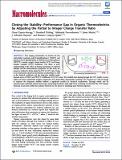Por favor, use este identificador para citar o enlazar a este item:
http://hdl.handle.net/10261/201361COMPARTIR / EXPORTAR:
 SHARE
BASE SHARE
BASE
|
|
| Visualizar otros formatos: MARC | Dublin Core | RDF | ORE | MODS | METS | DIDL | DATACITE | |

| Título: | Closing the Stability–Performance Gap in Organic Thermoelectrics by Adjusting the Partial to Integer Charge Transfer Ratio |
Autor: | Zapata Arteaga, Osnat; Dörling, Bernhard CSIC ORCID; Perevedentsev, Aleksandr; Martín, Jaime CSIC ORCID; Reparaz, J. S. CSIC ORCID; Campoy Quiles, Mariano CSIC ORCID | Palabras clave: | Impurities Electrical conductivity Doping Stability Polymers |
Fecha de publicación: | 28-ene-2020 | Editor: | American Chemical Society | Citación: | Macromolecules 53 (2): 609-620 (2020) | Resumen: | Two doping mechanisms are known for the well-studied materials poly(3-hexylthiophene) (P3HT) and poly(2,5-bis(3-alkylthiophen-2-yl)thieno[3,2-b]thiophene) (PBTTT), namely, integer charge transfer (ICT) and charge transfer complex (CTC) formation. Yet, there is poor understanding of the effect of doping mechanism on thermal stability and the thermoelectric properties. In this work, we present a method to finely adjust the ICT to CTC ratio. Using it, we characterize electrical and thermal conductivities as well as the Seebeck coefficient and the long-term stability under thermal stress of P3HT and PBTTT of different ICT/CTC ratios. We establish that doping through the CTC results in more stable, yet lower conductivity samples compared to ICT doped films. Importantly, moderate CTC fractions of ∼33% are found to improve the long-term stability without a significant sacrifice in electrical conductivity. Through visible and IR spectroscopies, polarized optical microscopy, and grazing-incidence wide-angle X-ray scattering, we find that the CTC dopant molecule access sites within the polymer network are less prone to dedoping upon thermal exposure. | Versión del editor: | http://dx.doi.org/10.1021/acs.macromol.9b02263 | URI: | http://hdl.handle.net/10261/201361 | ISSN: | 0024-9297 | E-ISSN: | 1520-5835 |
| Aparece en las colecciones: | (ICMAB) Artículos |
Ficheros en este ítem:
| Fichero | Descripción | Tamaño | Formato | |
|---|---|---|---|---|
| Zapata_Macromolecules_2020_editorial.pdf | Artículo principal | 5,23 MB | Adobe PDF |  Visualizar/Abrir |
| Zapata_Macromolecules_2020_suppl_editorial.pdf | Información complementaria | 1,68 MB | Adobe PDF |  Visualizar/Abrir |
CORE Recommender
Page view(s)
172
checked on 24-abr-2024
Download(s)
239
checked on 24-abr-2024
Google ScholarTM
Check
Este item está licenciado bajo una Licencia Creative Commons

